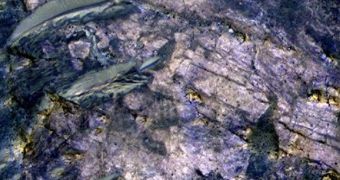For many years, planetary geologists have been trying to find the answers to two burning questions – where is all the carbon that should be seen on Mars, and why is the planet so dense. A new study may resolve both those issue in a fell swoop.
Using the mineral-mapping instrument on the NASA Mars Reconnaissance Orbiter (MRO), experts were able to find carbonates (carbon-rich rocks) deep under the planetary surface. These rocks were exposed by ancient asteroid impacts.
The Compact Reconnaissance Imaging Spectrometer for Mars (CRISM) was designed specifically to conduct mineralogy studies, and to find materials such as iron, oxides, phyllosilicates, and carbonates, which are all indicative that water once flowed on the Red Planet.
As experts analyze our neighbor more and more, it's becoming increasingly clear that its atmosphere is a lot less dense than it should be. Vast amounts of various forms of carbon can no longer be seen.
Fortuitously, MRO managed to pick up the signature of carbonates at several locations on Mars, where ancient impacts exposed to soils up to 5 kilometers (3 miles) beneath the surface. The findings are very important, geologists say.
They provide additional credence to the theory stating that the carbon needed to make carbonate minerals may have originated from carbon dioxide found in the early, thick Martian atmosphere.
This hypothesis has been proposed years ago, but until now there were little evidence to support it. If the CRISM instrument can identify additional locations that feature carbonates, then researchers could show that deposits of such minerals are extensive.
This would certify the fact that indeed mineral formation was the main mechanism that led to the Red Planet losing most of its atmospheric CO2.
“We're looking at a pretty lucky location in terms of exposing something that was deep beneath the surface,” explains Cornell University planetary scientist James Wray.
He is the author of a study reporting on the new discoveries. The paper was detailed yesterday, March 8, at the Lunar and Planetary Science Conference near Houston.
“A dramatic change in atmospheric density remains one of the most intriguing possibilities about early Mars. Increasing evidence for liquid water on the surface of ancient Mars for extended periods continues to suggest that the atmosphere used to be much thicker,” says Richard Zurek.
The expert, who is a project scientist for the MRO, is based at the NASA Jet Propulsion Laboratory (JPL), Pasadena, California. The JPL manages the MRO mission for the space agency's Science Mission Directorate, at NASA Headquarters, in Washington DC.
A deeper understanding of the fate of Martian CO2 will be gained once the American space agency launches the Mars Atmosphere and Volatile Evolution Mission (MAVEN), in 2013.

 14 DAY TRIAL //
14 DAY TRIAL //